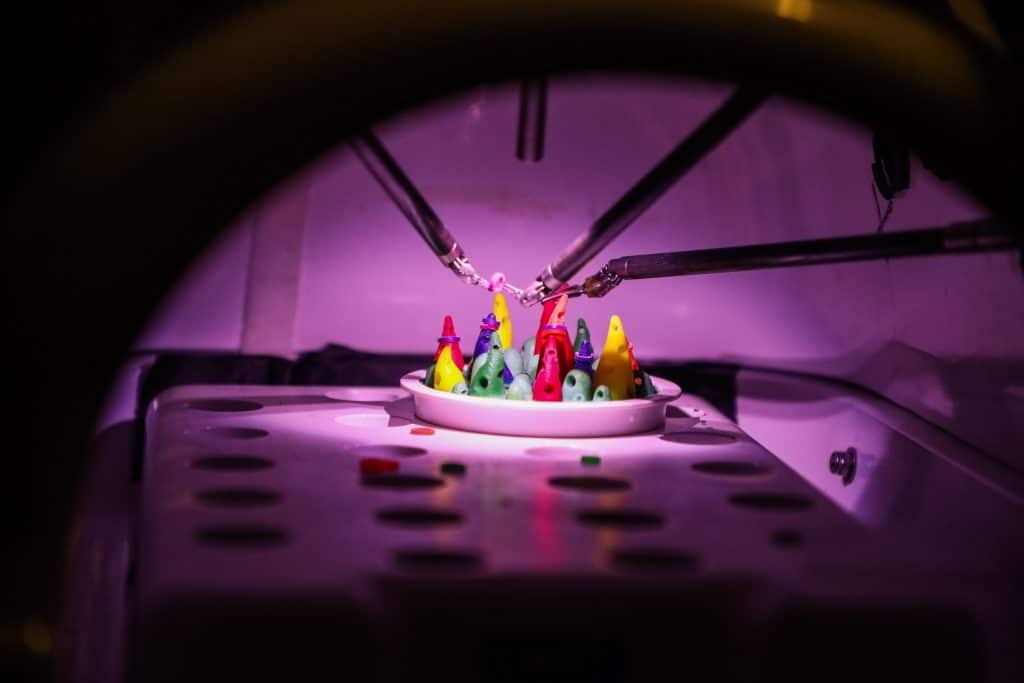Vail Health celebrates two years of robotic surgery with da Vinci surgical system
Operations with the hospital’s da Vinci surgical system have shown reduced pain, improved recovery times and a reduction in narcotics prescriptions

Chris Dillmann/Vail Daily
In December of 2020, Vail Health welcomed a new member to its surgical staff: the da Vinci XI surgical system. The arrival of the da Vinci XI created a robotic surgery department. Now, two years later, 11 Vail Health surgeons use the robotic system for a wide variety of surgeries including abdominal, hernia, gynecological and urological procedures. In total, da Vinci has been utilized in more than 600 procedures.
On Wednesday evening, the Vail Health Foundation hosted an event at the Vail hospital to showcase the technology and tout the improved outcomes it has resulted in.
“Our mission here is about elevating health in our community and this is one of the many ways that we get to do that,” said Amanda Veit, chief operating officer of Vail Health. “This allows us to truly give precision surgeries in so many different ways, and it really relates to our mission in that people heal faster and get back out on the mountain or to doing whatever it is that they love to do here.”
The hospital’s robotic surgery department is led by Dr. Turner Lisle, who serves as the medical director for the department as well as a general surgeon, specializing in comprehensive hernia procedures. Lisle’s first foray into robotics was during his training at the University of Virginia in 2010.

VHRobotics-VDN-012723-5
Since then, he’s seen robotics evolve and improve outcomes for patients, in the same way that other surgical innovations have done in the past.

Support Local Journalism
“When we look at the tale of robotics, we can compare it to laparoscopy, we can compare it to lumpectomy for breast cancer, compare it to hernia mesh for hernia surgery,” Lisle said, adding that when gallbladders went from being removed through a “big, huge incision” and cholecystectomies started being performed laparoscopically, older surgeons called it out for being more dangerous, more expensive and taking more time.
With time, however, “data started to show that it was better and quicker and recoveries were easier and people had less pain,” he said.
Now, robotics are doing the same thing: pushing the needle forward and improving outcomes for patients.
What da Vinci does

VHRobotics-VDN-012723-2
The first misconception that Lisle has to dispel when talking about robotic surgeries is that the robot is not conducting the surgery while the surgeon merely watches over everything.
Rather, he refers to the system as a “very sophisticated instrumentation and very sophisticated visualization that allows us to do surgery in ways that we can’t normally do with laparoscopic instruments.”
“It’s not like C-3PO or Johnny 5 is sitting at the bedside doing the surgery, it is essentially an extension of the surgeon’s hands, the surgeon’s vision,” Lisle said.
The da Vinci robotic system consists of two parts: the console where the surgeon sits, which controls the other part — the large robotic façade that has the instruments used during surgery.
The specific benefits of this system include magnification up to 10X, 3D visualization (compared to 2D visualization that comes with “traditional” laparoscopic surgery), enhanced ergonomics for surgeons, as well as more dynamic and precise motion of instruments.
The latter benefit, the way that the instruments move, is one of the technology’s greatest innovations — and is one of the main reasons Lisle loves using the da Vinci system.
The system mimics the surgeon’s hand movements, bending and rotating in real-time during the procedure. The instruments are able to move more like a human hand compared to traditional laparoscopic instruments, which can only rotate on a fixed axis (open and close, up and down). It’s a motion that Lisle described as being akin to using chopsticks.
With the da Vinci instruments having “more degrees of freedom than the human wrist” surgeons can maneuver more efficiently, and they can be “finer with dissection and much more precise with separating different tissue planes,” Lisle described.

VHRobotics-VDN-012723-3
“When we learn how to operate, we operate with our hands. We operate through big incisions; we’re doing everything with our fingers and our hands,” Lisle said. “And then you get into this laparoscopic realm, where you’re operating with these straight instruments — they call them straight sticks — that rotate and open and close, but they don’t function like your hands do. And you learn how to use them and you adapt. You change the way you might potentially approach a problem.”
However, da Vinci allows surgeons to operate more intuitively, operating more as they would using their hands, he added.
“This is an extension of my right hand and an extension of my left hand. It allows me to do exactly what my hands want to do, through an 8-millimeter incision,” Lisle said.
“It’s a minimally-invasive operation that allows us to mimic the human touch.”
How da Vinci improves outcomes
While da Vinci improves matters from the surgeon’s perspective, the true benefit is in the improved outcomes for patients.
“It’s definitely renewed my love for surgery in a lot of ways, because I can see how the patients are doing so much better, across the spectrum,” Lisle said.
Because the da Vinci instruments allow for more precise movements — as well as smaller incisions — this can reduce tissue damage, resulting in overall reduced tissue trauma, reduced pain and faster return to activities.
“That’s probably the biggest thing: It gets people back to getting active a whole lot sooner than we would traditionally do with laparoscopic platforms and it decreases the need for narcotic pain medication,” Lisle said.
Specifically, Lisle reported that in the past two years “we’ve lowered our narcotics prescribing almost across the board 75% since the initiation of da Vinci, compared to our laparoscopic cases.”
As an example, Lisle spoke about how da Vinci has “revolutionized abdominal wall reconstruction.”
In the past, Lisle said that he would do “big, open abdominal wall reconstructions,” where patients would have to remain in the hospital for six or seven days on IV pain medication. After leaving the hospital, patients would be sent home with a narcotics prescription for pain and would face another six to eight weeks of recovery before returning to activities.
Now, however, when the same operation is done robotically, patients must stay at the hospital overnight, they “take an average of two or three Tylenol” and can return to their normal activities in two to three weeks, he said.
The future of robotics in surgery

VHRobotics-VDN-012723-4
Medical company Intuitive released the da Vinci surgical system in 2014.
Right now, da Vinci is the only surgical robot approved by the U.S. Federal Drug Administration, Lisle said. However, there are others on the way, including systems from both Medtronic and Johnson & Johnson. These releases, Lisle, said will go a long way in furthering this technology by driving down the cost of such equipment and increasing access for more hospitals and doctors.
“Not all hospitals are lucky like we are, especially hospitals the size that we are,” Lisle said, adding that more competition in the market would “decrease costs and hopefully be able to get robotic platforms to more people in more places.”
Plus, looking ahead, he expects more innovations in the way of artificial intelligence to decrease the potential of complications in surgery.
But for now, Vail Health’s team of surgeons continues to use the da Vinci robotic system to improve outcomes for all.
“It’s essentially just another tool in our armory to be able to take care of people the best way possible,” Lisle said.











